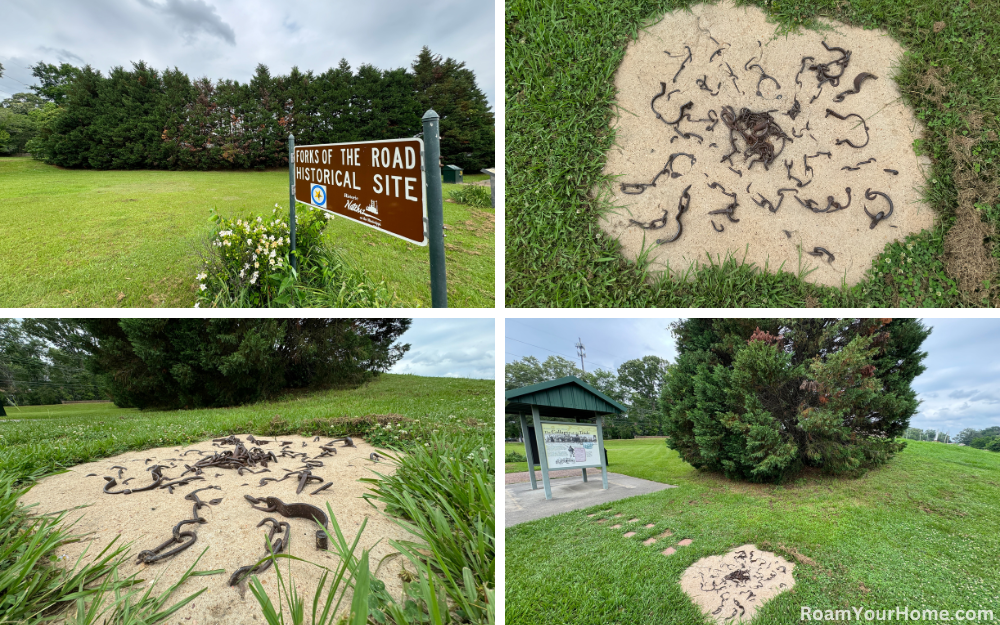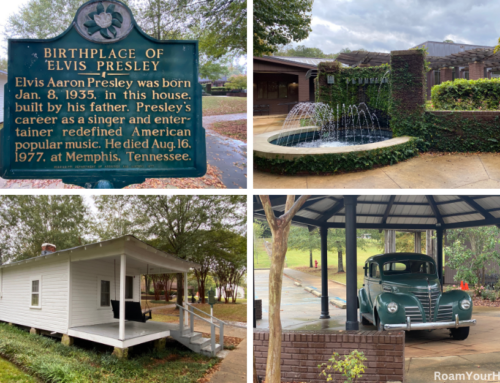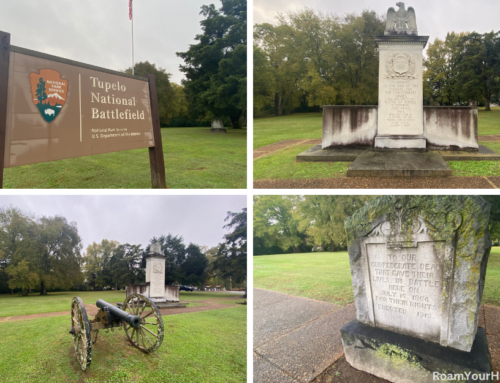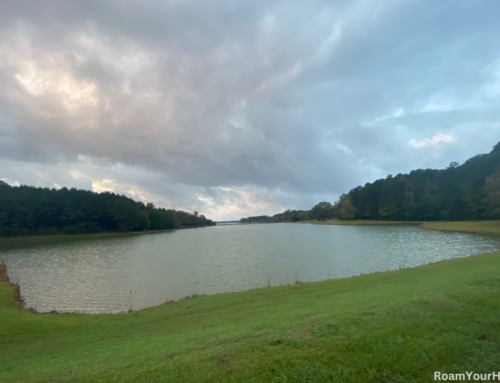
Forks of the Road Slave Market: Natchez National Historical Park
In the historic city of Natchez, Mississippi, Forks of the Road stands as a sobering reminder of America’s painful past. Today, driving by the intersection on Liberty Road, it looks little more than a small public park. But, this was once the second-largest slave market in the Deep South. This site witnessed thousands of enslaved individuals being bought and sold before the Civil War. Today, as a part of the Natchez National Historical Park, it serves as a memorial, offering an opportunity to reflect on its significance.
Visiting Forks of the Road in Natchez National Historical Park
We visited on a cloudy afternoon. It had been raining off and on all afternoon. Getting out of the car, I immediately knew this would be an emotional stop.
Walking through the site, interpretive markers detail the history of the market, the people who suffered here, and the economic forces that fueled the domestic slave trade.
While no original buildings remain, the impact of the stories shared is undeniable. The site’s quiet presence in the city contrasts sharply with its dark past.
Beyond the interactive displays, there is an artistic depiction of slave manacles and chains in a block of concrete on the very ground where tens of thousands of enslaved people were sold.
We spent about half an hour at the site, reading signs and contemplating the awful history of a couple of acres of land.
A Brief History of the Forks of the Road Slave Market
The Forks of the Road slave market played a key role in the domestic slave trade. It served as a nexus of American history’s largest forced labor migration.
Between 1800 and 1860, more than 750,000 enslaved African-Americans were moved from the upper to the lower south. Facilitating the forced migration of thousands of enslaved African Americans from the Upper South to the Deep South.
The Rise of the Forks of the Road
In the early 19th century, as the cotton industry boomed in Mississippi and other Southern states, there was an increasing demand for enslaved labor. While the international slave trade had been banned in 1808, the domestic trade flourished, with traders moving enslaved people from states like Virginia, Maryland, and Kentucky to the Deep South.
With the invention of the cotton gin and an ever-expanding steamboat transportation network, Natchez became the epicenter of American capitalism in the mid-19th century. Due to its proximity to the Mississippi River and its economic importance as a port, Natchez was the ideal location to create an economy centered around slave labor-generated cotton.
The Forks of the Road market, established in the 1830s, grew rapidly as traders transported enslaved individuals by riverboats or forced marches. It quickly became one of the busiest slave markets in the country.
Conditions at the Market
At the Forks of the Road, enslaved men, women, and children were held in pens and auctioned to the highest bidder. Traders such as Isaac Franklin and John Armfield—who ran one of the largest slave-trading firms in the U.S.—transported enslaved people from Virginia and other states to be sold in Natchez. Buyers, primarily large plantation owners, sought out young men and women to work their cotton fields, where they endured grueling labor and harsh conditions.
Witness accounts describe the Forks of the Road as a place of immense suffering, where families were often ripped apart from one another. Enslaved individuals were forced to endure medical examinations, humiliating displays, and bargaining between buyers and sellers. The market was also a site of brutal discipline, as traders used whips, chains, and other methods to control those they enslaved.
The End of the Market
The market remained active from 1833 until the arrival of federal troops on July 13, 1863. When Union troops occupied Natchez, enslaved people who had been held at the Forks of the Road were liberated. Many joined the Union Army or sought protection in “contraband camps” set up by federal forces. The market site was abandoned, and its buildings and slave pens were torn down, some by men who were sold in them.
A First Hand Account of Forks of the Road Slave Market
The newly created 58th Regiment of the U.S. Colored Troops assisted in dismantling the Forks in the Road Slave Market. In a letter to the Milwaukee Sentinel, an unidentified member of the 12th Wisconsin described the event.
“Our first quarters were in a long range of barracks used for a number of years as slave pens. Very many of the men composing the regiment had been sold in them; brought from Kentucky, Tennessee, Virginia and other slave States, in large gangs ironed, they were placed in these dungeons until a sale could be effected… As the position was very much exposed, we were ordered to construct barracks within the fortifications and to tear down these slave pens to obtain lumber to build them. This order was received just at evening and was hailed with the wildest enthusiasm by these men who had been chained, gagged and whipped, and suffered tortures unutterable within these same walls, and through that long night they worked with a terrible earnestness and the morning saw the slave pens of Natchez leveled to the ground, never, it is hoped to be again reconstructed. During this work many a thrilling remimbrence [sic] was recalled of the cruelty of traders, of sad partings of husband and wife, of inhuman fathers selling their own children, and a thousand other incidents illustrating the detestable state of society at the South.”
The story of the Forks of the Road slave market is a powerful reminder of the realities of slavery in the United States. The site is a part of the Natchez National Historical Park to ensure its preservation and education for future generations. It helps ensure that by remembering history, we acknowledge the lasting impact of slavery and honor the lives of those who endured it.



